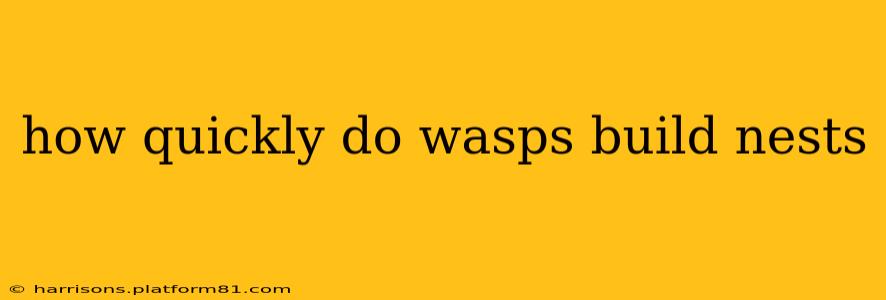Wasps are fascinating creatures, and their nest-building prowess is truly remarkable. But just how quickly do these industrious insects construct their intricate homes? The answer, as you might expect, isn't a simple one. The speed of wasp nest construction depends on several key factors, which we'll explore in detail below.
What Factors Influence Wasp Nest Building Speed?
Several factors contribute to the varying speeds at which wasps build their nests:
-
Species: Different wasp species build nests at different rates. Some solitary wasps might take weeks to complete a single cell, while social wasps, like paper wasps or yellow jackets, can construct large nests with hundreds of cells in a matter of weeks. The complexity of the nest design also plays a role; intricate structures naturally take longer to build.
-
Weather Conditions: Warm, sunny weather is ideal for wasp nest construction. Cold temperatures, rain, and strong winds can significantly slow down or even halt the process. Wasps are ectothermic (cold-blooded), so their activity is directly impacted by ambient temperature.
-
Availability of Resources: Wasps need readily available materials to build their nests, primarily wood pulp for paper wasps or mud for mud daubers. A scarcity of these resources will naturally slow down construction. Similarly, access to food sources for the larvae is crucial, as the colony's growth rate directly impacts nest expansion.
-
Colony Size: Larger colonies of social wasps can build nests much faster than smaller ones, simply due to the increased number of workers available to contribute to the construction. A thriving colony with a strong queen and many active workers will see rapid nest development.
-
Nest Stage: The rate of nest building isn't constant. Initial nest construction, when the queen is laying the foundation, is often slower than the later stages when worker wasps join the effort. As the colony expands, the building speed tends to accelerate.
How Long Does It Take to Build Different Types of Wasp Nests?
While precise timelines are difficult to give without knowing specific species and conditions, we can offer some general estimates:
-
Paper Wasps: These wasps can build a substantial nest, often containing several hundred cells, within a few weeks to a couple of months, depending on the factors discussed above. The initial stages might be slower as the queen establishes the nest, but it accelerates rapidly as workers emerge.
-
Yellow Jackets: These social wasps are incredibly efficient builders. A thriving colony might construct a large, complex nest containing thousands of cells within a single season (spring to autumn).
-
Mud Daubers: Mud dauber nests are built cell by cell and can take a considerable amount of time, often stretching over several weeks or even months, as each cell requires careful construction and drying.
What Materials Do Wasps Use to Build Their Nests?
The materials used in wasp nest construction vary greatly depending on the species:
-
Paper Wasps: These wasps chew on wood fibers, mixing them with saliva to create a paper-like substance used to build their nests. You often find their nests under eaves, overhangs, or in sheltered locations.
-
Yellow Jackets: Their nests are typically constructed underground or in cavities, and they use a similar paper-like material.
How Can I Tell If Wasps Are Building a Nest Near My Home?
Early detection is key to preventing wasp nests from becoming a problem. Watch out for:
- Increased wasp activity in a specific area.
- Small, papery structures appearing under eaves, in sheds, or in the ground.
- Unusual chewing sounds originating from your home's exterior.
If you suspect wasp nest construction, carefully observe the area from a safe distance. Never attempt to remove a wasp nest yourself unless you are experienced in pest control and have the appropriate safety equipment.
Are Wasp Nests Always Expanding?
While wasp nests generally expand during the active season, their growth rate isn't constant. It slows as resources diminish, the weather turns colder, or the colony nears the end of its life cycle.
This comprehensive guide provides a detailed understanding of wasp nest building speeds and related factors. Remember, wasp behavior is complex, and these are general observations. The specifics can vary greatly depending on the species and environmental circumstances.
